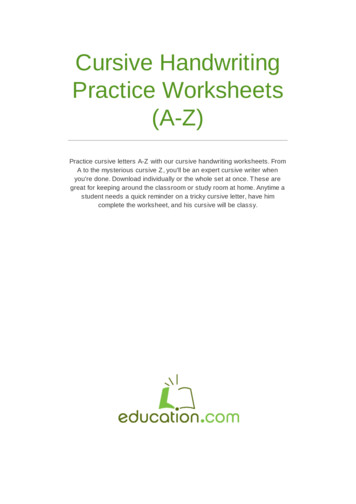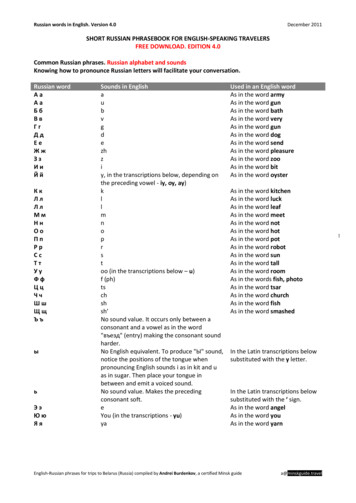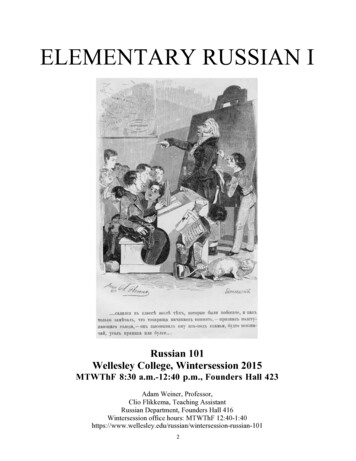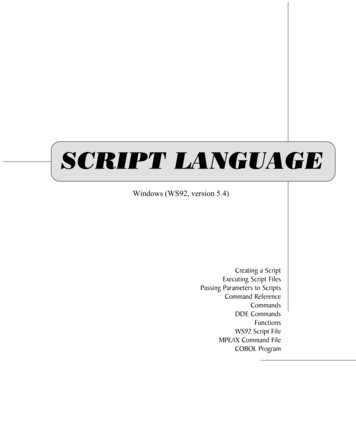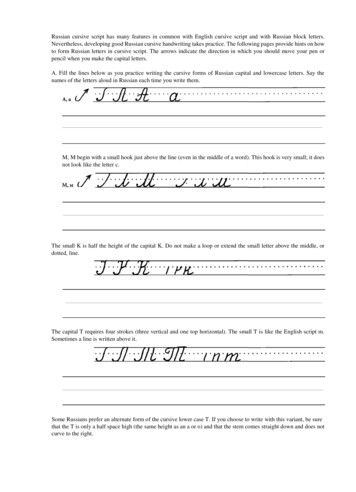
Transcription
Russian cursive script has many features in common with English cursive script and with Russian block letters.Nevertheless, developing good Russian cursive handwriting takes practice. The following pages provide hints on howto form Russian letters in cursive script. The arrows indicate the direction in which you should move your pen orpencil when you make the capital letters.A. Fill the lines below as you practice writing the cursive forms of Russian capital and lowercase letters. Say thenames of the letters aloud in Russian each time you write them.M, M begin with a small hook just above the line (even in the middle of a word). This hook is very small; it doesnot look like the letter c.The small K is half the height of the capital K. Do not make a loop or extend the small letter above the middle, ordotted, line.The capital T requires four strokes (three vertical and one top horizontal). The small T is like the English script m.Sometimes a line is written above it.Some Russians prefer an alternate form of the cursive lower case T. If you choose to write with this variant, be surethat the T is only a half space high (the same height as an a or o) and that the stem comes straight down and does notcurve to the right.
Now practice writing the following words. Russians do not write stress marks, but your instructor may have youwrite them for practice.The left bar of the small p extends straight below the line and the part of the letter above the line does not close(contrast this to the cursive small-letter p in English).
The final stroke of the capital У remains on the line and turns to the left and stops. It does not extend below the line,as the small y does.Most Russian letters connect from the baseline to the following letter. As you can see in the examples below, thisconnecting stroke is drawn to about half the height of the next letter. Practice writing the following words.
b. As you practice writing cursive forms of the capital and small letters, continue to say the names of the letters aloudin Russian each time you write them.Make the Б with three strokes: a vertical downstroke, a horizontal cross stroke, and a looping stroke. The small бlooks somewhat like the English cursive d but terminates by trailing off to the top right.
The top of the small г must be rounded. Do not make it angular or flat like the English cursive r.The next letter looks like the numeral 10 with a bar in between.The small И does not have the hook that M, M have (and that's the only difference!).Ш, ш should not be made to look like the English cursive W, w. The middle stroke is the same height as the firstand last strokes, and the last stroke returns all the way down to the line and bends to the right. Sometimes the smallm is underlined to help it stand out.Л, л begin with a small hook (like M, M).
Like M, M and Я, я (both capital and small) must always be preceded by a tiny hook.The capital 3 is indented on the right side, very much like the numeral 3. Make it in one stroke.Make Э, э by forming a backward C and then adding a cross stroke. Do not indent it on the right like the 3.The two dots that distinguish E from Ë are not usually used by Russians, but you should make a habit of using them.Now make a series of the upper- and lowercase З, Э and E, one after the other. Remember the distinctive features ofeach!
Now practice writing some words and phrases with these letters.Don't forget the hooks before л, м, and я!
B. Write the following words in cursive script. Say them aloud as you write them.Kaк?eró
KTOЭTOТанянетКатяКто это?
Урок 1, Часть перваяCasual greetings and introductionsr. Write out in Russian what you would say when . . .
l. you greet a friend on the street.2. you ask your friend the name of a man in your Russian class.3. you want to learn the name of the person you're talking with.4. you introduce yourself to someone.5. you tell your friend the name (Áннa) of a woman in your class.ЧACTЬ BTOPAЯДомашняя работа (Homework)
ПИСЬМО (Written exercises)New letters and sounds: Group BA. Fill the lines below as you practice writing the cursive forms of Russian capital and lowercase letters. Say thenames of the letters aloud in Russian each time you write them.Note carefully the strokes used to form Ф, ф.Note carefully the strokes used to make Ж.Й, й always have the "half-moon" over them. It is never omitted. It is what distinguishes the consonant from thevowel И.
The final stroke of Ч, ч must turn to the right. It never goes below the line.The ь (мягкий знак [soft sign]) has no sound of its own. It never starts a word, so there is no capital letter for it incursive script.b. Write the following words in cursive script. Pay close attention to how you join the letters. Say the words aloud andremind yourself of their meaning.Letters should connect into at the top of the left stroke.
ЧTO ЭTO?Cпасибо.
to form Russian letters in cursive script. The arrows indicate the direction in which you should move your pen or pencil when you make the capital letters. A. Fill the lines below as you practice writing the cursive forms of Russian capital and lowercase letters. Say the names of the letters aloud in Russian each time you write them.
